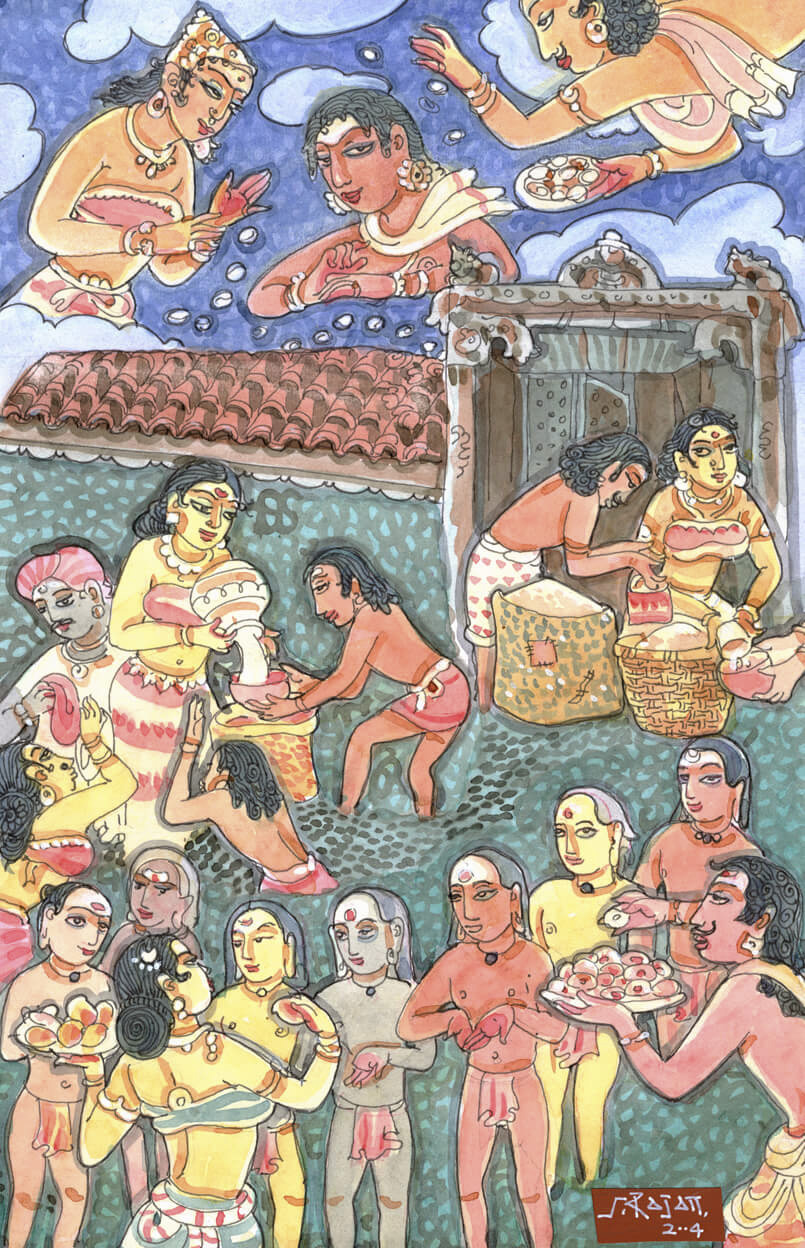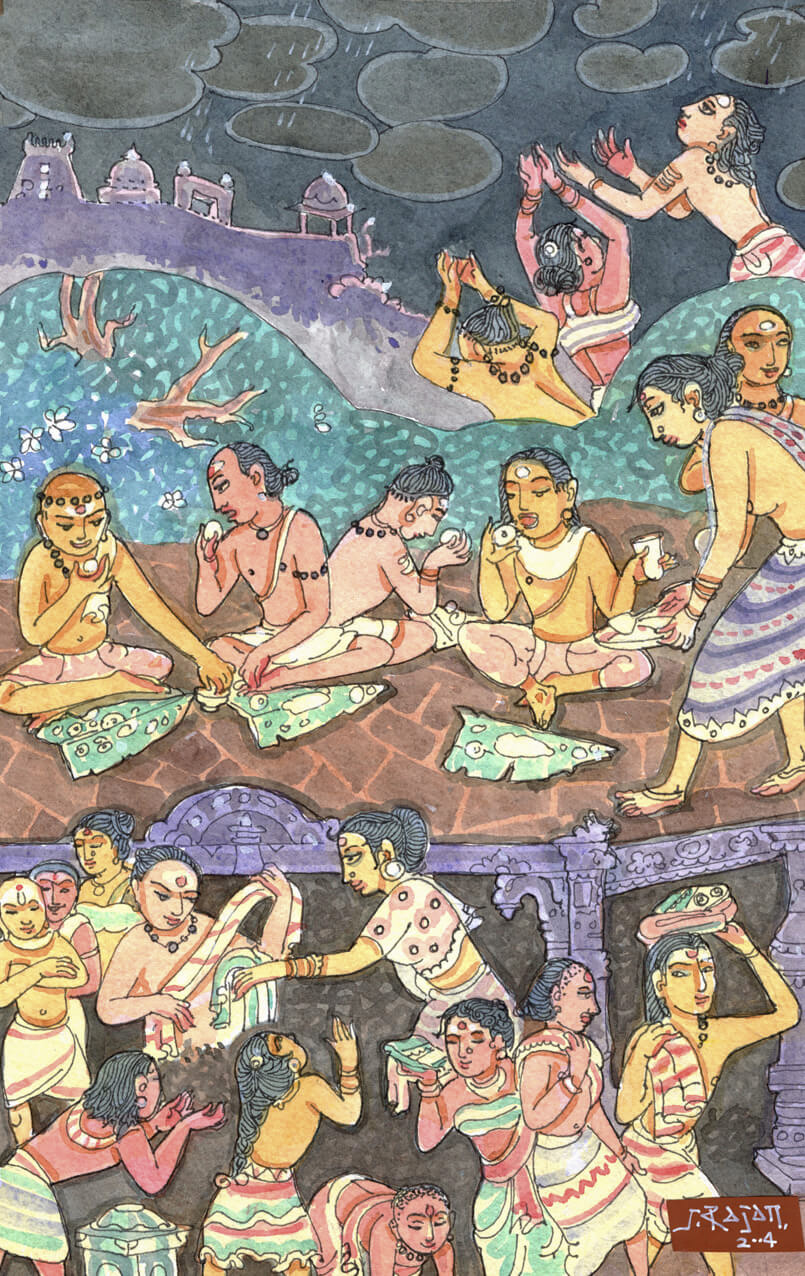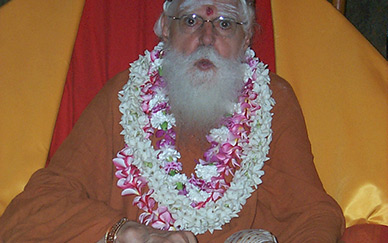The Concept of Awareness – Part Seven
Satguru Bodhinatha Veylaswami gives an Part 7 of his upadesha series on the concept of awareness and omnipresence from the yogic perspective.
Tropical Showers to End the Phase
Aum Namah Sivaya
Beginning yesterday evening, Kauai received heavy cloud cover. This released countless gallons of rainwater along with booming thunder throughout the night. This morning our plants are very happy and our monks are very much carrying umbrellas. Today marks the end of our phase. Our monks are finishing up their work for the week before they head into three days of retreat. Aum.
"Nothing is lost, nothing is gained. How can we talk of gain or loss? The atma is one-it is all and everywhere. So how can there be loss and gain, coming and going, past and future?" Yogaswami
Ashram Sadhana Day

Jai Ganesha!
Every month our monks partake in a full morning of cleaning the monastery. This day is known as Ashram Sadhana day, and it gives each monk time to more thoroughly care for their assigned cleaning area, as well as to touch up areas that don't get much attention. Today the first project was doing some cleaning at Iraivan Temple, followed by office cleaning and then work on individually assigned cleaning areas. If you found yourself cleaning something today, you might just be inwardly aligned with our monks! We hope you're now enjoying more tidy personal surrounding as well. As Gurudeva would say, if you feel that the energy in your life isn't moving, one of the first things you should try is cleaning! Aum.
Mauritius February Ganesha Homa

Click below for more photos of the February homa at our Spiritual Park, which also constituted the annual student prayers which had been delayed. Visit: www.saivasiddhanta.org
Tirukural – Chapter 23

Chapter 23: Charity

Verse 226
A rich family is seen personally feeding the poor in their home, a temple and the marketplace. They have learned that to relieve the hunger of the less fortunate is the right use of their wealth. They receive the blessings of the inner plane deities.
You can access the entire text, in Tamil and English here:
Weaver's Wisdom
Verse 221
Giving to the poor is true charity.
All other giving expects some return.
Verse 222
Though some may declare it a good path, garnering gifts is bad.
Even if they say it denies one Heaven, giving gifts is good.
Verse 223
Men of good birth graciously give,
never uttering the wretched excuse, "I have nothing."
Verse 224
How unpleasant a beggar's pleading can become,
until one sees his face so sweetly pleased.
Verse 225
Great, indeed, is the power to endure hunger.
Greater still is the power to relieve others' hunger.
Verse 226
Relieving the ravaging hunger of the poor
is a right use for wealth men have obtained.
Verse 227
The fiery scourge called hunger never touches
the man who shares his daily meal with others.
Verse 228
Is it because they are unaware of the joys of giving
that hard-hearted men waste their wealth by hoarding it?
Verse 229
More bitter than even a beggar's bread is the meal
of the miser who hoards wealth and eats alone.
Verse 230
There is nothing more bitter than death;
yet even death seems sweet when giving is impossible.
Topping the Lava Rock Wall

Jai Ganesha!
This week Umut and his team from Innov8 construction have begin adding the top layer of stones to Iraivan Temple's lava rock wall. The east side of the wall is nearing completion and this is the last layer of added stone upon it. They are able to move quickly, since this part doesn't require large amounts of concrete. It does however need a very strong mix that can withstand the countless years of rains that will fall upon these top pieces. Umut must also go through ever joint while the concrete is wet and make it look more natural and finished. He tells us that once we remove the tarps, to won't take long for the elements to turn all the stones a uniform dark-grey color. It should look striking in juxtaposition to the white granite temple above. Aum Namah Sivaya.
The Concept of Awareness – Part Six
Satguru Bodhinatha Veylaswami gives an Part 6 of his upadesha series on the concept of awareness and omnipresence from the yogic perspective.
Here, Satguru presents many words from the meditative language of Shum. below are some definitions of some of the words he uses:
niif»
1) Individual awareness or perception, which differs from vast consciousness; 2) the observation of individual awareness; 3) individual awareness distinguished from impersonal consciousness; 4) the perception of being aware. 5) pronounced niif», though often pronounced and written simply as nif.
uu»
1) Connect together, join or bind; 2) in this area of the mind things or concepts are connected, joined or bound together; 3) the focus of individual awareness is simultaneously upon two or more areas of the mind at the same time.
niimf»
1) Awareness flowing through the mind, being singularly aware of one area and then another; 2) niimf constantly changes its name to the name of the area it becomes conscious in while traveling, and is only called niimf when it is the thread of consciousness traveling or in between one of the names of awareness and another; 3) for instance, niimf when traveling through balikana (Seeing light by looking out upon and through the fourth dimension of the mind) is then called balikana, and when traveling through the experience of narehrehshum it is named that; 4) niimf can travel from the seventh to the fourth dimension; its home is in the fifth and fourth dimensions but it usually resides in the fourth looking at the third, in contrast to iif, which is the observation of awareness flowing only through the higher areas of mind; 5) awareness as psychic sight and hearing; 6) awareness traveling, while seeing with the inner eye and hearing with the inner ear, into and out of areas of the mind; 7) represented in mamsani maa» and mambashum maa» by a flowing line between portraits; 8) pronounced niimf, often pronounced and written simply as nimf.
nalif
1) Meditation, holding the vibration from one shumnuhm' to another; 2) continuity between meditations; 3) after shumnuhm', or any type of meditation practice, pilgrimage or temple puja, a vibration fills one and remains with one long after; this vibration, or current, or sidisi, is called nalif; 5) nalif should be held from meditation to meditation or puja to puja; 6) it can be likened to a phrase in music, each time the nalif vibration wears thin, we should reconstruct that area through shumnuhm' (Guided group meditation in the Shum language), puja or another meditation; 7) nalif is generally held within the vibration of the kalingkasim kamshumalinga (5th chakra); 8) it is possible to go in consciousness into bivumbika (3rd chakra), rehmtyenali (4th chakra), tyemavumna (6th chakra) or kamakadiisareh (7th chakra) and not break the nalif, but getting into a detailed discussion or argument within rehnamtyevum (2nd chakra), or being remorseful or reminiscing the past in akaiilisimbi (1st chakra), would break the nalif; 9) it would then, with some effort, have to be reestablished; 10) nalif is especially necessary to those yogi tapasvins who hope to advance in their raja yoga on the Saiva path.
mamsani
(meditation) 1) One of a special set of 12 simple mambashum that Gurudeva created, one for each month of the year; 2) a mini-drawing of Shum concepts; 3) a map to guide the meditator through various interrelated areas of the mind.
mambashum
(yoga) 1) A drawing of Shum concepts describing inner states of mind; 2) a map to guide the meditator through various interrelated areas of the mind; 3) excellent for group as well as individual meditations.
kamshumalínga
1) Any of the chakras, which are nerve plexes or centers of force and consciousness within the inner bodies of man; 2) refers to all twenty-one chakras—the seven principal chakras, the seven chakras or nadis above the crown of the head and the seven chakras below the muladhara; 3) through transmutation, one unfolds through the seven principal kamshumalinga maa as awareness and kundalini break the seals of these force centers; 4) the kamshumalinga maa may also be understood as windows of mind or consciousness through which awareness looks out or in on the phenomenal world; each window has its own influence and coloring effect on the process of perception.
Bivumbika, rhemtyenali, kalingkasim, tyemavumna, kamakadiisareh
3rd, 4th, 5th, 6th and 7th chakras
Tirukural – Chapter 22

Chapter 22: Understanding One's Duty to Give

Verse 211
A man and woman are distributing food and clothing to impoverished people in the marketplace. Elsewhere they feed the hungry. Above, rain clouds gather at the distance and citizens offer their gratitude for the life-giving waters.
You can access the entire text, in Tamil and English here:
Weaver's Wisdom
Verse 211
The benevolent expect no return for their dutiful giving.
How can the world ever repay the rain cloud?
Verse 212
It is to meet the needs of the deserving
that the worthy work so hard to acquire wealth.
Verse 213
Of all duties, none is better than benevolence,
whether in this world or that of the Gods.
Verse 214
He who understands the duty of giving truly lives.
All others shall be counted among the dead.
Verse 215
The wealth of a community-loving wise man
may be likened to a well-filled village water tank.
Verse 216
Riches retained by the big-hearted resemble fruits
ripening on a tree in the heart of a village.
Verse 217
In the hands of a generous man,
wealth is like a medicinal tree whose healing gifts help all.
Verse 218
Those who know duty deeply never neglect giving,
even in their own unprosperous season.
Verse 219
The benevolent man considers himself poor only
when he is unable to render his accustomed duty to humanity.
Verse 220
Were it said that loss of wealth is the price of generosity,
such loss would be worth selling one's self to acquire.
New Sign for the Banyan Tree
Back in 2004 during Guru Purnima monks and devotees gathered to plant this special banyan tree. It's called Pillar Banyan and the official name is Ficus bengalensis. At the time of planting it was about 10 inches tall in a one-gallon pot.
It grew, and grew. If you look closely at this photo, to the right you will see that the branches of the tree engulfed the original sign which was attached to the trunk and is now barely visible. So we made a new sign recently, and with knowledge added by experience put it well away from the tree.
Something a bit charming is happening. The tree is surrounding some granite stones we stored near it years ago, swallowing them (see other photos). One day they will be inside the tree.
This will be an immense tree one day. There is one in Bengal that was so big Alexander the Great camped his entire army of 7,000 soldiers under it during his failed attempt to conquer India. You can read the new sign for more background.
The tree will live for two thousand years or more, growing old along with Iraivan Temple.
The Concept of Awareness – Part Five
Satguru Bodhinatha Veylaswami gives an Part 5 of his upadesha series on the concept of awareness and omnipresence from the yogic perspective.
From Our Gurus' Teachings
Archives are now available through 2001. Light colored days have no posts. 1998-2001 coming later.

